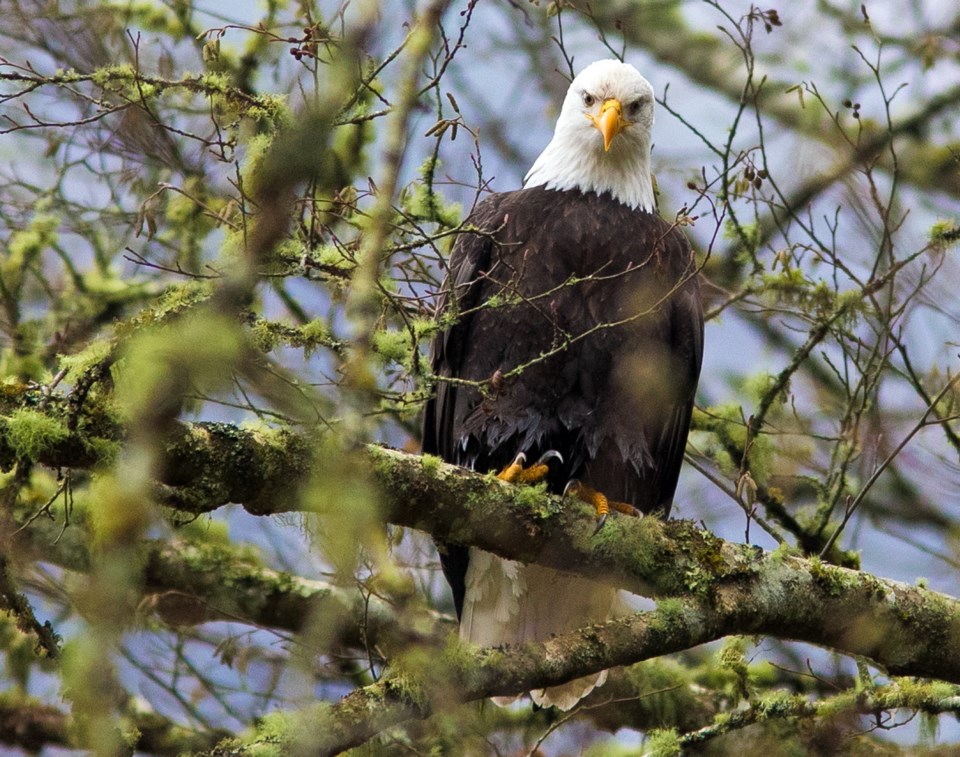By law, it is illegal in B.C. to cut down the nest trees of bald eagles. In reality, however, if the nests get in the way of industrial development, the provincial government is prepared to see them sacrificed, even over the concerns of its own wildlife staff.
That is what freedom-of-information documents show happened on the Campbell River waterfront this year when a company received government permission to cut down two eagle-nest trees on 13 hectares of industrial property to allow a coal-loading facility.
“This doesn’t happen very often,” said Wayne Wall, an environmental consultant for the company. “I was surprised we got approval.”
The province issued a permit on Jan. 23, 2014, to Middle Point Harbour Limited Partnership exempting it from Section 34 of the Wildlife Act, which prohibits destroying eagle nests. The exemption was signed by Mike Stalberg, the province’s manager of recreational fisheries and wildlife for the West Coast region. The company cut the trees without any requirement for compensation.
After the trees were removed, a pair of eagles built a nest in a different part of the property, Wall said.
Middle Point originally filed an application to remove the trees on Dec. 12, 2012.
Tom Pallan, president of the Pallan Group, said in a letter to the province that two evergreens, a Sitka spruce and grand fir, had to be moved to make way for a deep-sea dock facility, primarily for shipping coal. He described the facility as a partnership with the We Wai Kai (Cape Mudge) First Nation and the Pallan Group.
“The land in question has to [be] cleared, levelled and hard surfaced,” he wrote.
An assessment determined that the spruce had rot and might fall within five years, but that the fir was healthy and that neither posed a significant risk to the “people, equipment and building on-site.”
On May, 6, 2013, Stalberg wrote to Pallan to say he had the authority to issue a permit under “exceptional circumstances where there is compelling necessity,” typically where there are concerns for safety of the public or eagles. He noted provincial biologists had concerns about the tree cutting and that suitable nest trees “have become increasingly rare” on Campbell River’s industrial shoreline.
The FOI documents include a Dec. 18, 2012, email from Margaret Henigman, provincial ecosystems biologist, who said she is upset that Campbell River is supporting the request even though “they assured me that they would not support development designs which resulted in the need to remove these trees.”
She added: “We really do not want to see the loss of these trees and there is no justification for it. The property is plenty large enough not to have to remove them.”
On June 18, 2013, Pallan submitted a report by consulting biologist Ian Moul noting that one tree was last used in 2010 and the other in 2013. The report said that if both trees were cut, the eagles would likely nest in the area to the north and south.
On Sept. 23, 2013, Wall’s Strategic Natural Resource Consultants wrote a report saying heavy industrial use “will significantly reduce the likelihood of the nest being used by a breeding pair of bald eagles in the future.” He adds there is a high density of nests and potential nest sites in the area.
On Jan. 14, 2014, Stalberg wrote to Pallan to say that he was not convinced that the company had “fully explored alternative plans” that could allow the development to proceed while retaining the nest trees and, as such, denied the request.
Then, on Jan. 22, after receiving further details on the development itself, Stalberg wrote an email saying the revised permit request has been evaluated and that the “applicant has provided a rationale for why they feel it is necessary” to cut the trees. The exemption permit would be granted.
On April 10, Henigman stated in an email: “We should have asked for mitigation for the loss of habitat. As it stands we don’t know the activity status of the nests when they were taken down … and nothing to compensate for the loss.” The company argued no eagles were actively nesting in the trees at the time of removal and that compensation is not needed because of the dense number of eagles in the region and the availability of other trees for nests.
No one in the Ministry of Forests, Lands, and Natural Resource Operations was available to comment.
In 2013, a Campbell River man was fined $10,000 for cutting a bald eagle nest on his private property.
B.C. Wildlife Act
Birds, nests and eggs
B.C. WILDLIFE ACT: BIRDS, NESTS AND EGGS
34 A person commits an offence if the person, except as provided by regulation, possesses, takes, injures, molests or destroys
(a) a bird or its egg,
(b) the nest of an eagle, peregrine falcon, gyrfalcon, osprey, heron or burrowing owl, or
(c) the nest of a bird not referred to in paragraph (b) when the nest is occupied by a bird or its egg.



